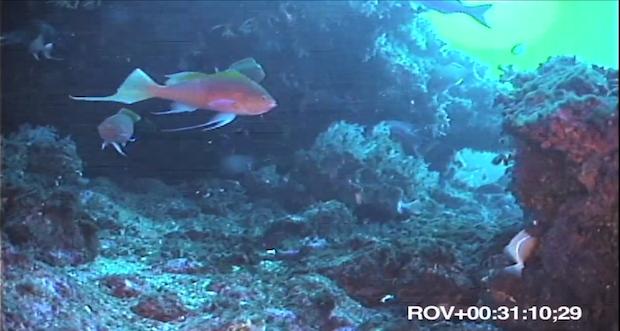It’s strange how sometimes you stumble upon a treasure that’s been buried for ages just sitting there waiting for a pasty cream coloured man and his metal detector to come and pick it up from the beach. That’s pretty much the case here with this incredible video footage showing some of the fish living at Grattan Seamount. This video and accompanying story has been around since November 2011, but we only stumbled across it yesterday and buzz went our beach metal detector.
The full article can be found on the explorations blog here, where it explains the deployment of an ROV used to explore a mountain top 300ft below the surface. The video was filmed along the Mid-Atlantic Ridge between the remote islands of St. Helena and Ascension islands. The names of the latter two islands may set bells ringing inside the minds of rare fish aficionados.
Indeed, at least in the context of the aquarium trade, Ascension islands is home to some of the rarest fish species that are no longer available in the current day. In the old days, Centropyge resplendens, Chaetodon sanctaehelenae as well as Prognathodes dichrous were the main players coming out of that little mount of sea rock. Endemism is also high with interesting species such as Priolepis ascensionis, Amblycirrhitus earnshawi and Xyrichtys sanctaehelenae just to name a few.
As mentioned in their article, the seamount where the ROV had been deployed was a guyot, which essentially means the geology was in the past a volcano that has been eroded at its top into a flat plateau by oceanic waves. While nothing much in terms of fish life was observed at the summit, the rocky outcrops along the sides provided a better habitat for smaller species.

In the ROV video as well as the photos provided in the article, two species immediately stood out for us. Firstly, a pair of Prognathodes dichrous can be seen making a brief cameo in the video. P. dichrous has been documented only at St. Helena and the Ascension islands, but it doesn’t make sense for a species to have a disjunct range in-between the two localities. The ROV capture shows for the first time this species in Grattan Seamount, thereby linking the two known ranges together with this serving as an intermediate. Makes sense since Grattan is situated in-between the two.
Then there is that INCREDIBLE anthias that you see swimming all over the video. I know you must be wondering what it is and why are we taking so long to get to it. Although in the video it was mentioned as Holanthias fronticinctus, this identification is erroneous. We took the time to really consult the authorities on this before sharing it.
Joe Rowlett mentioned that the anthias in film could possibly be H. caudalis instead. H. caudalis was of course named after the incredible ray extensions on the caudal fin, which is diagnostic of this species. It is known only from Ascension islands, which Grattan Seamount is closer to than St. Helena. H. fronticinctus on the other hand was described based on a convex caudal fin with no mention of any filaments. Holanthias as genus was erected based on this convex caudal fin of H. fronticinctus, and to this day only houses two species.
All this were of course just speculations, so we reached out to Jack Randall, William Anderson and Phillip Heemstra for a consult. Their replies were unanimous in this species being H. caudalis, and a 2012 review by Anderson and Heemstra was sent to us. Under the Holanthias section of the paper review, it mentioned that H. caudalis was only known from two specimens collected at 120 and 170m (390-550ft) of water in the Ascension islands. H. fronticinctus remains an endemic of St. Helena and it is not known if the two species mix in the connecting regions of the two islands, or if they even ranged that far out of their known locales.

This video is therefore important in a few key aspects. H. caudalis and P. dichrous were filmed for the first time in situ using a deepwater ROV, and both in a previously undocumented range. P. dichrous now fills the connection between the two islands, and H. caudalis is now found outside of the Ascension islands, currently up to Grattan.
Apart from the misidentification mix up, this video is pretty incredible. If you were wondering why it looks so bright down at depth, it’s probably because it was filmed in a seamount where waters are usually pretty clear. We’d like to thank Joe Rowlett, Jack Randall as well as Anderson and Heemstra for their help in properly identifying this species.
For more detailed information on this expedition, please check out the expedition article featured below.



